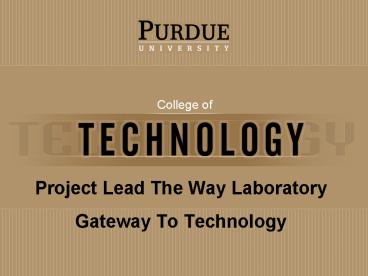School of Technology - PowerPoint PPT Presentation
Title:
School of Technology
Description:
The following Project Lead The Way laboratory design was developed by technology ... Automation and Robotics: Students learn about the history and development of ... – PowerPoint PPT presentation
Number of Views:356
Avg rating:3.0/5.0
Title: School of Technology
1
College of
Project Lead The Way Laboratory
Gateway To Technology
2
The following Project Lead The Way laboratory
design was developed by technology education
majors at Purdue University as part of their IT
471 course Managing the Technology Education
Laboratory instructed by Dr. George E. Rogers
3
- Facility Design Proposal
- The New Technology
- Education Laboratory
- Prepared by
- Mr. Steven Schellenberger and Mr. Jeff Totsch
4
Table of Contents
- Computer workstation design
- PLTW Safety equipment
- PLTW Laboratory equipment list
- GTT Unit Cost Totals
- PLTW Laboratory Layout
- Sources
- PLTW Suppliers
- Questions
- PLTW Introduction
- Gateway To Technology (GTT)
- Mission Statement
- PLTW Proposal Objective
- Acoustics
- Color
- Illumination
- Ventilation
5
Project Lead The Way
- The introduction of technology into the
technology education classroom and laboratory
requires a new facility design to fully
incorporate the - Gateway To Technology curriculum.
6
Project Lead The WayOpportunities for Students
- PLTW in the Technology Education classroom and
laboratory allows all students the opportunity to
be exposed to pre-engineering courses, as well as
receive college credit. With PLTW courses,
students will be more prepared for their future
after high school.
7
Gateway To Technology (GTT)
GTT is a state-of-the-art program in the Middle
School Industrial Technology Education Department
that incorporates national standards in science,
mathematics, and technology for todays grade 6-8
classroom and laboratory. GTT consists of four
instructional units that motivate and excite
students to be creative and innovative during
instruction and laboratory activities.
Each 10-week instructional unit enables students
to accomplish goals of the project, while
offering students learning challenges at all
ability levels.
8
- The Gateway To Technology program consists of
- four independent instructional units
- Design and Modeling An introduction into the
design process where students use measurement and
descriptive geometry, learn sketching techniques,
as well as create models and document ways to
solve problems (Rube Goldberg). - The Magic of Electrons Students learn through
hands-on activities and projects about the
science of electricity, circuit design, sensing
devices, and the movement of atoms (PC Board
Power Etching ). - The Science of Technology This unit seeks to
investigate how science has affected technology
throughout history (Dragster). - Automation and Robotics Students learn about
the history and development of automation and
robotics. This unit covers computer control
systems, machine automation, energy transfer, and
structures (Fischertechniks).
9
- Our mission is to train and prepare students for
their future by enhancing their personal growth
and helping them become active partners in the
transformation of the nations schools for an
advancing technological society. - National Standards met Standard 8 H,I Standard
9 I,K - Standard 17 I,M,O,P,Q Standard
18 J,L,M - Standard 19 M,N,O,P Standard 20 J,K,L,M,N
10
Proposal Objective
- Our new design consists of four major
objectives - Allow for safer working conditions for all
students and faculty - Create a dust-free room for projects and
activities involving computers - Provide space for a first aid station and
additional space for demonstrations and
instructional materials, a dust collection
system, and fire-safe rooms - Construct an educational environment that fosters
the learning of skills and concepts that students
will use in future life experiences
11
Acoustics
- Acoustics control noise for
- students and faculty
- Dust collector and air compressor in own room
- Ceiling should have a minimum sound
- absorption of 75
- Carpet eliminates floor-generated noises and
reduces heating and floor maintenance
12
Color
- The color of the classroom and laboratory
- serves many purposes
- The room color must first give the student, the
faculty, and the public a sense of safety. The
room color must be simple and safety friendly. We
suggest light blue because lighter colors make
the room appear larger, and it is relaxing,
soothing, and calm. - Painted safety lines on laboratory floor
- Personal safety equipment is color-coded for easy
visibility for students and faculty.
13
Illumination
- Lighting is very important for learning
- Natural lighting from five windows (two in
classroom and three in laboratory) located six
feet up from the floor. - Artificial lighting rating between 50-70
foot-candles for the classroom and 75-150
foot-candles for the laboratory. - Lighting is located directly above workstations
and students desks to give the best possible
lighting.
14
Ventilation
- Clean air is important to good health
- Delta Ambient Air Cleaner
- Item 12500160 416.00 EA
- Torit Cyclone Dust Collector,3 PH 208/230/640V w/
motor magnet control - Item 12599377 5665.00 EA
15
Computer Workstation Design
- Many activities now require the use of a
computer. A well-designed workstation will - increase comfort
- reduce fatigue
- increase productivity
16
Safety Equipment
- Eye protection equipment
- Use ANSI-Z87 with side shields or goggles when
around small, flying objects. - Use splash-proof goggles when working with
hazardous or mixing chemicals. - Use Z136.1-1980 eyewear when working with laser
beams. - Eye wash station, First aid kit, and wash sink in
laboratory
17
(No Transcript)
18
Front of classroom
Back of laboratory
19
- In conclusion, we believe that our facility
design will allow for safer working conditions
for all students and faculty. - Our goal is to construct an educational
environment that fosters the learning of skills
and concepts that students will use in future
life experiences
20
Sources
- ITEA. (2000). Standards for Technological
Literacy Content for the Study of Technology. - Storm, G. (1993). Managing the occupational
education laboratory. (2nd Ed.). Prakken
Publications, Inc. - Retrieved November 10, 2004. http//www.pltw.org/m
ses.shtml
21
Leading the Way In K-12 Engagement

